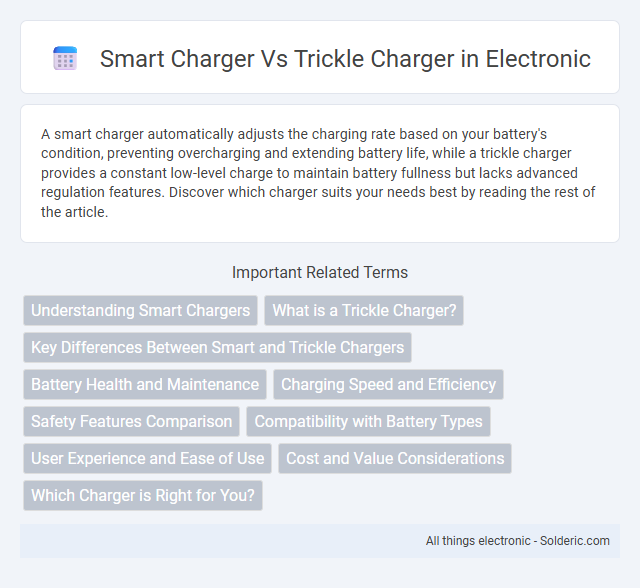A smart charger automatically adjusts the charging rate based on your battery's condition, preventing overcharging and extending battery life, while a trickle charger provides a constant low-level charge to maintain battery fullness but lacks advanced regulation features. Discover which charger suits your needs best by reading the rest of the article.
Comparison Table
| Feature | Smart Charger | Trickle Charger |
|---|---|---|
| Charging Method | Automatically adjusts current and voltage | Delivers low, constant current |
| Charging Speed | Faster, can fully charge in hours | Slow, may take days to charge fully |
| Battery Type Compatibility | Supports multiple battery types (Li-ion, Lead Acid, AGM) | Primarily for lead-acid batteries |
| Automatic Shutoff | Yes, prevents overcharging | No, continuous charging |
| Safety Features | Overcharge, short circuit, and reverse polarity protection | Minimal safety features |
| Ideal Use | Regular charging and maintenance for modern batteries | Maintaining battery charge over long periods |
| Cost | Higher due to advanced technology | Lower, simple design |
Understanding Smart Chargers
Smart chargers use microprocessor-controlled technology to monitor battery condition, automatically adjusting the charging current and voltage to optimize battery health and prevent overcharging. They provide efficient charging for various battery types, including lead-acid, lithium-ion, and AGM batteries, by using multi-stage charging algorithms and temperature compensation. Unlike trickle chargers, which supply a constant low voltage to maintain battery charge and can cause damage if left connected too long, smart chargers deliver precise, safe, and energy-efficient charging tailored to the battery's needs.
What is a Trickle Charger?
A trickle charger is a low-voltage battery charger designed to maintain a battery's charge by supplying a continuous, slow current, preventing overcharging and battery depletion. Unlike smart chargers, trickle chargers lack advanced monitoring features and cannot automatically adjust charging rates based on the battery's condition. Your choice between a smart charger and a trickle charger depends on whether you need simple maintenance charging or intelligent, adaptive battery management.
Key Differences Between Smart and Trickle Chargers
Smart chargers automatically adjust charging current based on battery condition, preventing overcharging and optimizing battery health, while trickle chargers provide a continuous low current to maintain charge. Smart chargers offer faster charging times and advanced features like temperature monitoring, whereas trickle chargers are simpler and primarily used for long-term maintenance. Your choice depends on whether you need intelligent battery management or basic charge maintenance.
Battery Health and Maintenance
Smart chargers continuously monitor your battery's voltage and temperature to provide optimal charging, preventing overcharging and extending battery life. Trickle chargers supply a steady, low current to maintain battery charge but lack intelligent regulation, which can lead to battery sulfate buildup and reduced capacity over time. Choosing a smart charger improves battery health by adapting to your battery's needs, ensuring efficient maintenance and longevity.
Charging Speed and Efficiency
Smart chargers deliver faster charging speeds by automatically adjusting current based on the battery's state, optimizing efficiency and reducing charge time. Trickle chargers provide a slow, steady charge that maintains battery health but requires significantly longer periods to reach full capacity. The intelligent regulation of smart chargers prevents overcharging and energy waste, making them more efficient for modern battery maintenance.
Safety Features Comparison
Smart chargers incorporate advanced safety features such as automatic shutoff, overcharge protection, and temperature monitoring to prevent battery damage and overheating. Trickle chargers provide a continuous low current that reduces the risk of overcharging but typically lack sophisticated sensors, making them less effective at detecting faults or temperature changes. Choosing a smart charger enhances your battery's safety and longevity by ensuring precise control over the charging process.
Compatibility with Battery Types
Smart chargers offer broad compatibility with various battery types, including lead-acid, AGM, gel, and lithium-ion, delivering tailored charging profiles that optimize battery health and performance. Trickle chargers primarily support traditional lead-acid batteries and provide a low, continuous charge, which may not be ideal for advanced battery chemistries like lithium-ion. For vehicles or devices with modern battery technologies, smart chargers ensure safer, more efficient charging by adjusting current and voltage according to the battery's specific requirements.
User Experience and Ease of Use
Smart chargers offer a superior user experience with automated charging cycles that adjust to your battery's condition, preventing overcharging and extending battery life. Trickle chargers require more manual monitoring as they supply a constant low current, which can lead to battery damage if left connected too long. Your convenience is enhanced with smart chargers through features like automatic shut-off and diagnostic capabilities, making them easier and safer to use.
Cost and Value Considerations
Smart chargers generally have a higher upfront cost than trickle chargers, but they offer superior value by preventing overcharging and extending battery lifespan through intelligent charging cycles. Trickle chargers are more affordable initially but may cause battery damage or reduced efficiency over time due to constant low-level charging without regulation. Investing in a smart charger can save you money in the long run by maintaining optimal battery health and reducing replacement frequency.
Which Charger is Right for You?
Choosing between a smart charger and a trickle charger depends on your battery maintenance needs and usage patterns. Smart chargers feature automatic voltage regulation and multi-stage charging, making them ideal for regular use and long-term battery health by preventing overcharging. Trickle chargers provide a constant low amperage charge suitable for maintaining batteries over extended periods without complex electronics, often preferred for classic cars or infrequent use.
Smart charger vs trickle charger Infographic

 solderic.com
solderic.com